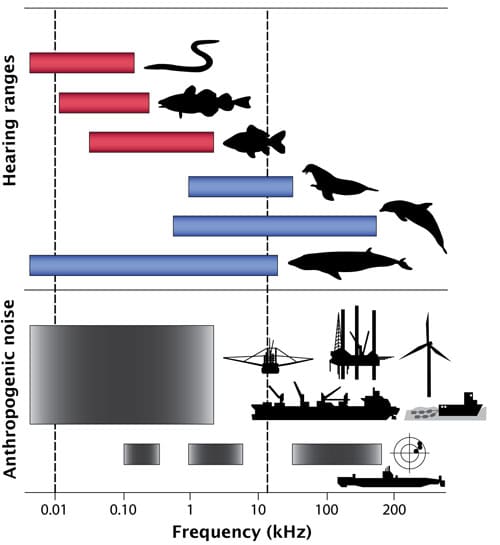Sailing voyagers interested in the health of the oceans are likely to think they should sail more and use their engine less. The obvious reasons for this approach (other than sailing being fun, of course) are to use less carbon-based fuel and to limit air pollution. Another reason however, might not be so obvious since it takes place beneath the waves.
Most mariners are likely think of the health of the oceans in visual terms: plastic trash strewn across the surface, chemical pollution from oil spills, or the bleaching of coral reefs due to elevated ocean temperatures. We can see all these problems and imagine the effects these issues can have on marine organisms. Yet, according to some scientists, there is another type of environmental pressure that human activity is putting on marine life: growing levels of noise as the ocean becomes increasingly “industrialized.” Two groups of scientists, the Scientific Committee on Oceanic Research (SCOR) and the Partnership for Observation of the Global Oceans (POGO) are getting together to study this problem. The SCOR and POGO scientists are developing what they call the International Quiet Ocean Experiment (IQOE), to determine current man-made sound levels and if that volume of human sound is affecting marine life.
According to a recent article in Oceanography magazine written by IQOE scientists, “human noise has become the dominant component of marine noise in some regions, and noise is directly correlated with the increasing industrialization of the ocean.” Further, the effects of this rising level of human-produced noise is unknown, but most researchers are convinced the effect will be negative. “Sound is an important factor in the lives of many marine organisms, and theory and increasing observations suggest that human noise could be approaching levels at which negative effects on marine life may be occurring.”
Without further research into the sound damage thresholds of various marine organisms, scientists can’t be sure about the effect of rising sound levels. Man-made noise in the ocean has been increasing across much of the frequency spectrum, but especially below 500 Hz.
Of course not all sound in the ocean comes from human sources. Natural causes include rain, ice movement, and the sounds of the marine animals themselves. Another major natural source of sound is bubbles. Breaking waves produce vast numbers of bubbles and the sound of these bubbles collapsing produces a steady background noise in the oceans. During the Cold War, the U.S. Navy had the problem of tracking the positions of Soviet submarines. One way the Navy did this was to place hydrophones on the ocean bottom across the “choke points” used by Soviet subs to enter the North Atlantic — the Denmark Strait between Greenland and Iceland, and the straits between Iceland and Great Britain. These hydrophones picked up the sound of the Soviet subs, but they also picked up all the other sounds of the ocean. For this system to work, the Navy needed to understand the natural sounds and then remove those from the received sound. Once the sounds of whale calls, bubbles bursting and other natural sounds were removed, the remainder was the sound of ships and submarines passing through the straits.
One of the biggest sources of noise pollution in the ocean is commercial shipping. According to the IQOE scientists, the volume of cargo transported by shipping has been doubling approximately every 20 years. In the past several years shipping has reportedly increased 12 decibels above the natural background level in some locations.
Another source of noise that seems likely to grow as the world increases petroleum demand is offshore oil exploration and production. Exploration vessels tow hydrophones that send out high energy blasts of sound and then measure the reflections to determine the undersea geological structure. Even renewable energy sources like wind turbines placed offshore can contribute to the underwater noise level.
The IQOE scientists write that “several species of whales have adjusted their communication calls in a manner that suggests they are ‘raising their voices’ or otherwise changing their calls in order to be heard.” And it is possible that some marine species simply stop vocalizing when in situations of high background noise.
Clearly, the contribution of voyaging boats is a small drop in the bucket compared to other man-made noise sources in the oceans of the world. However, in high-noise areas like the approaches to major ports, the noise from the collected recreational vessels only adds to the noise present from commercial shipping, fishing vessels, etc. Sailors, especially, can do their part by shutting off their engines and sailing as much as they can. In busy waters, a little less noise can’t hurt.

